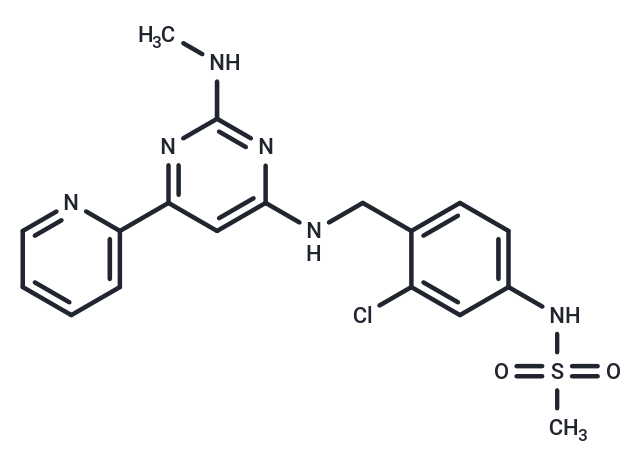Shopping Cart
Remove All Your shopping cart is currently empty
Your shopping cart is currently empty
TC-G-1008 (GPR39-C3) is a zinc receptor agonist with EC50 values of 0.4 nM for rat GPR39 and 0.8 nM for human GPR39.

| Pack Size | Price | USA Warehouse | Global Warehouse | Quantity |
|---|---|---|---|---|
| 1 mg | $32 | In Stock | In Stock | |
| 5 mg | $73 | In Stock | In Stock | |
| 10 mg | $123 | In Stock | In Stock | |
| 25 mg | $226 | In Stock | In Stock | |
| 50 mg | $372 | In Stock | In Stock | |
| 100 mg | $619 | In Stock | In Stock | |
| 200 mg | $877 | - | In Stock | |
| 1 mL x 10 mM (in DMSO) | $80 | In Stock | In Stock |
| Description | TC-G-1008 (GPR39-C3) is a zinc receptor agonist with EC50 values of 0.4 nM for rat GPR39 and 0.8 nM for human GPR39. |
| Targets&IC50 | GPR139 (human):0.8 nM, GPR39 (rat):0.4 nM |
| In vitro | TC-G-1008 demonstrates selectivity over a panel of kinases (IC50s>10 μM) and lacks significant binding affinity for the related ghrelin and neurotensin-1 receptors (IC50s>30 μM)[1]. GPR39-C3 acts as a positive allosteric modulator in HEK293-GPR39 cells, activating cAMP production (downstream of Gs), IP1 accumulation (downstream of Gq), SRF-RE-dependent transcription (downstream of G12/13), and β-arrestin recruitment, and induces dose- and time-dependent loss of response in cAMP production upon second challenge[2]. |
| In vivo | Rat and mouse plasma protein binding for TC-G-1008 is 99.3% and 99.1%, respectively. TC-G-1008 is the first potent GPR39 agonist (EC50s ≤ 1 nM for human and rat receptor) that is orally bioavailable in mice and significantly induces acute GLP-1 levels. Following single oral doses of 10, 30, and 100 mg/kg of aqueous suspensions in 0.5% methylcellulose/0.1% Tween 80, TC-G-1008 achieves maximal exposures of 1.4, 6.1, and 25.3 μM, respectively, between 1 and 1.5 hours[1]. |
| Kinase Assay | HEK293-GPR39 cells are plated and cultured in poly-d-lysine-coated, white, 384-well plates (4000 cells/well) in the growth medium overnight at 37°C in the presence of 5% CO2. For pretreatment of the cells with GPR39 ligands (TCG-1008) or vehicle control (DMSO), the culture medium is removed and the cells are stimulated with GPR39 ligands in assay buffer for the indicated time at 37°C. Then, the compound solution is removed and washed twice with PBS containing 0.1% BSA. For measurement of intracellular cAMP, the cells are stimulated with drugs in stimulation buffer for 30 min at 37°C. The intracellular cAMP level is determined by using HTRF cAMP dynamic 2 kit[2] . |
| Animal Research | Mice: Mice are given single oral doses of 10, 30, and 100 mg/kg of TC-G-1008[1] . |
| Synonyms | GPR39-C3 |
| Molecular Weight | 418.9 |
| Formula | C18H19ClN6O2S |
| Cas No. | 1621175-65-2 |
| Smiles | CNc1nc(NCc2ccc(NS(C)(=O)=O)cc2Cl)cc(n1)-c1ccccn1 |
| Relative Density. | 1.462 g/cm3 (Predicted) |
| Storage | Powder: -20°C for 3 years | In solvent: -80°C for 1 year | Shipping with blue ice/Shipping at ambient temperature. | |||||||||||||||||||||||||||||||||||
| Solubility Information | DMSO: 255 mg/mL (608.74 mM), Sonication is recommended. | |||||||||||||||||||||||||||||||||||
| In Vivo Formulation | 10% DMSO+40% PEG300+5% Tween 80+45% Saline: 2 mg/mL (4.77 mM), Sonication is recommended. Please add the solvents sequentially, clarifying the solution as much as possible before adding the next one. Dissolve by heating and/or sonication if necessary. Working solution is recommended to be prepared and used immediately. The formulation provided above is for reference purposes only. In vivo formulations may vary and should be modified based on specific experimental conditions. | |||||||||||||||||||||||||||||||||||
Solution Preparation Table | ||||||||||||||||||||||||||||||||||||
DMSO
| ||||||||||||||||||||||||||||||||||||
| Size | Quantity | Unit Price | Amount | Operation |
|---|

Copyright © 2015-2025 TargetMol Chemicals Inc. All Rights Reserved.